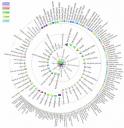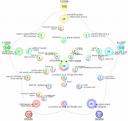O’ Reilly has drafted a blogger’s code of conduct. Here are my first thoughts:
1. We take responsibility for our own words and for the comments we allow on our blog.
always, if not being influenced by C2H5OH Continue reading Blogiquette
O’ Reilly has drafted a blogger’s code of conduct. Here are my first thoughts:
1. We take responsibility for our own words and for the comments we allow on our blog.
always, if not being influenced by C2H5OH Continue reading Blogiquette
First monday has an interesting paper on the 100 most visited Wikipedia pages for the period of September 2006 to January 2007 (Wikipedia is the ninth most visited site in the U.S. with 43 million visitors). The crystal search link in the paper does not work but the table reports that science ranks at place 5 – not too bad.



I have been batch printing PDFs for years with the built-in macro function of the Adobe Reader. For any unknown reason this doesn´t work anymore with my current OS / PDF / printer combination. The printer queue is always stuck or even detaches. I have therefore looked for a solution to delay the printing process. Most print utilitites do not help as I can´t delay spooling of print jobs. Here is my final solution – I am starting Acrobat first and send by DDE in long intervals a print command via pdfp
print.cmd
|wj_print.cmd|
We also have some local events here. Following the wizards-of-os last September (and the famous “I have been building a meme about read-write vs. read-only society” by Lawrence Lessing) the re-publica conference takes place in Berlin – culture / society / technical / business / other – but no science as far as I can see.
Nature medicine news has a short text about the sunshine cure.
The strongest evidence available is perhaps for the vitamin’s protective role in MS. Several studies have documented a dramatic ‘sunshine belt’ […] Latitude also seems to play a role in the incidence of hormone-dependent cancers. […] The effect is almost certainly because of vitamin D, Feldman says. “People tend to think it can’t do all these things when it’s a vitamin,” notes Feldman. “It’s not a vitamin, it’s a hormone.”
As always there seems no fun without risk. We could add links to arteriosclerosis and allergy.
Wikiquote has already a large collection:
* “All religions, arts and sciences are branches of the same tree.” – Albert Einstein
* “The antagonism between science and religion, about which we hear so much, appears to me purely factitious, fabricated on the one hand by short-sighted religious people, who confound […] theology with religion; and on the other by equally short-sighted scientific people who forget that science takes for its province only that which is susceptible of clear intellectual comprehension.” – Thomas Henry Huxley (1825–1895), “The Interpreters of Genesis and the Interpreters of Nature” (1885)
Continue reading Science and religion
I have completed today the collection of all writings of Lucie Adelsberger, a well known allergy specialist in pre-war Berlin before she was sent to Auschwitz. The following CV is taken from her thesis in 1920: Continue reading CV Adelsberger
The United States Holocaust Museum has just released “Crisis in Darfur” an online mapping project together with Google Earth. If you zoom in on Africa, you will find a lot of flames that may be clicked for more information.
In 2004 the U.S. Holocaust Memorial Museum declared a genocide emergency for Darfur, Sudan. To date about 2,500,000 civilians, targeted because of their ethnic or racial identity, have been driven from their homes, more than 300,000 people killed, and more than 1,600 villages destroyed by Sudanese government soldiers and government-backed militias, known as the “Janjaweed.” More than 200,000 Sudanese are refugees in neighboring Chad. The crisis continues as thousands more die each month from the effects of inadequate food, water, health care, and shelter in a harsh desert environment.
Continue reading Global awareness layer
Anglia English bookshop, München, Schellinstrasse

more desks … and 10 tips for keeping your desk clean…
I am still thinking about coping and resilience, and have read again Antonovsky‘s salutogenesis concept of a continuum between health and disease.
If we are not lucky to find any risk factor Continue reading Salutogenesis
Waiting to exhale was a book in 1992 (“Right now I am supposed to be all geeked up”). Waiting to exhale then was a movie in 1995 (“Friends are the people who let you be yourself… and never let you forget it”). And finally Waiting to exhale was the title of a meeting report 1995 Continue reading Waiting to exhale
The BMJ blog has a comment on “raising meteors” and other intelligent study acronyms. I will never understand how all this trials are being connected – maybe somebody could create a map like the famous Biochemical Pathway Maps by Roche?
The Lancet has a comprehensive review of bipolar disorders- finally I learned about the distinction between type I (includes mania) and type II (hypomania). BTW the author thinks that there is no sound evidence for the DSM-IV priority for mood changes; Kraepelin had no priority for mood, thinking or activity altering changes after all). Continue reading Hypomania
A new major release of my favorite software is definitely worth another entry here. Besides many other features there is now a new function to add tags to emails – quite important if you need to assign emails to different projects. Furthermore (virtual) search folder are now cached for speed, many thanks, yea, yea.